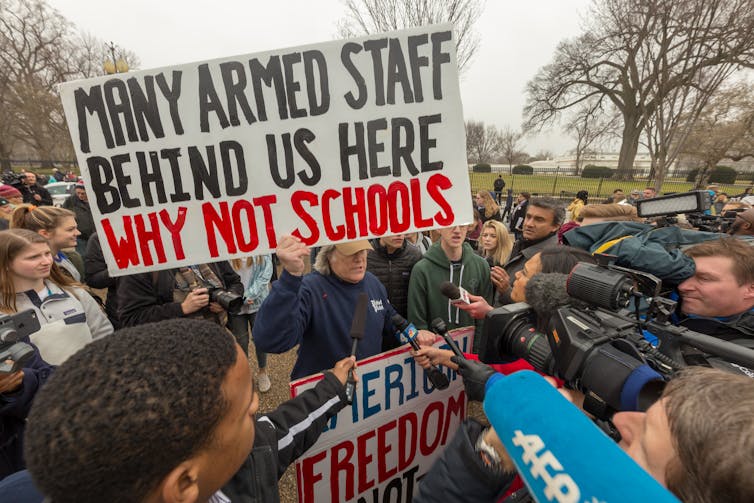Federal spending bill deals blow to school safety research
- Written by F. Chris Curran, Assistant Professor of Public Policy, University of Maryland, Baltimore County
Long before the current state of heightened attention to school shootings[1], my colleagues[2] and I began a two-year study[3] of school safety and the role of law enforcement officers in public schools.
Our work is funded by the Comprehensive School Safety Initiative[4] of the National Institute of Justice.
To date, the Comprehensive School Safety Initiative has funded[5] 100 research projects that involve almost US$250 million in total. Research projects have looked at things ranging from school emergency response plans to policing strategies that use alternatives to arrest.
 New funding for the Comprehensive School Safety Initiative has been suspended.
National Institute of Justice[6]
New funding for the Comprehensive School Safety Initiative has been suspended.
National Institute of Justice[6]
Collectively, this research is meant to build a robust evidence base so policymakers can use proven ways to keep students safe in school.
Last month, the NIJ put out a call for new research on school safety. This past Friday, however, this call was canceled[7]. To understand why, look to the recently passed federal spending bill.
Funding diverted from research
Thanks to the Consolidated Appropriations Act of 2018[8] – passed by Congress and signed on March 23 by President Donald Trump – the funding for school safety research is “no longer available for research and evaluation,” a recent NIJ notice states. “Instead, it will be used for other purposes under the STOP School Violence Act of 2018[9],” the notice states, in reference to legislation[10] passed as part of the spending bill. The STOP School Violence Act provides funding for several initiatives that include training of school personnel to identify and prevent violence, training of local law enforcement officers to respond to such violence, and implementation of security measures like metal detectors.
Perhaps unsurprisingly, my view as a school safety researcher is that this move to cut funding for school safety research represents a blow to school safety. The risk that comes with this move is that policymakers and practitioners will have less research to rely on as they seek ways to make schools safe.
To its credit, STOP specifies[11] that funded programs should be “evidence-based,” such as those “identified by the Comprehensive School Safety Initiative.” However, the reallocation of funds puts a pause on new school safety research under this initiative.
Continued research on school safety and security is important because existing research isn’t always clear as to what works. Furthermore, some of the common approaches to school safety have been shown to have negative impacts on schools.
Many mixed results
For instance, consider the increased presence of school resource officers in schools – an idea that has been put forth by school districts and a number of states, such as Florida[12]. As recently seen in Maryland[13], school resource officers can lessen the damage in the case of a violent incident in school. However, despite the power of that anecdote, the research on the impact of school resource officers as a whole is mixed.
 Demonstrators outside the White House support armed staff in schools.
Joseph Gruber/shutterstock.com[14]
Demonstrators outside the White House support armed staff in schools.
Joseph Gruber/shutterstock.com[14]
Some studies[15] suggest that school resource officers increase school safety. However, school resource officers have also been linked to undesirable outcomes, such as increases in school based arrests[16]. They have also been linked to possible increases in the use of suspensions[17] and severe discipline[18].
Similarly, certain school discipline policies, including the use of suspension and zero tolerance policies, have been linked to negative student outcomes[19] and racial disparities in discipline[20]. At the same time, emerging evidence[21] suggests that the rolling back of suspensions and zero tolerance policies might lead to more disruptive school environments. Yet, research on alternative forms of discipline, though developing, is limited[22]. This creates a quandary for policymakers considering discipline reform – a quandary that further research can help resolve.
Some solutions cause problems
Other areas of school safety research indicate that some common approaches may not be effective. For instance, the use of visible security measures, such as metal detectors and cameras, have been linked to lower school safety[23]. Research suggests that such security measures may also contribute to cultures of criminalization[24] or degrade school climate[25].
To be sure, it is important that adequate resources be provided directly to schools and law enforcement agencies to improve school safety – which is the approach taken by the STOP School Violence Act. That said, if policymakers do not have adequate school safety research to draw on, they may end up making policies that cause more problems than they solve. Cutting back on school safety research only makes this scenario more likely.
References
- ^ heightened attention to school shootings (www.nytimes.com)
- ^ colleagues (www.cavvresearch.com)
- ^ began a two-year study (news.umbc.edu)
- ^ Comprehensive School Safety Initiative (nij.gov)
- ^ funded (nij.gov)
- ^ National Institute of Justice (nij.gov)
- ^ this call was canceled (nij.gov)
- ^ Consolidated Appropriations Act of 2018 (www.congress.gov)
- ^ STOP School Violence Act of 2018 (www.congress.gov)
- ^ legislation (www.hatch.senate.gov)
- ^ specifies (www.congress.gov)
- ^ Florida (www.tampabay.com)
- ^ recently seen in Maryland (www.cnn.com)
- ^ Joseph Gruber/shutterstock.com (www.shutterstock.com)
- ^ studies (onlinelibrary.wiley.com)
- ^ school based arrests (onlinelibrary.wiley.com)
- ^ possible increases in the use of suspensions (link.springer.com)
- ^ severe discipline (nyupress.org)
- ^ negative student outcomes (www.apa.org)
- ^ racial disparities in discipline (journals.sagepub.com)
- ^ emerging evidence (www.manhattan-institute.org)
- ^ limited (educationnext.org)
- ^ lower school safety (link.springer.com)
- ^ contribute to cultures of criminalization (journals.sagepub.com)
- ^ degrade school climate (muse.jhu.edu)
Authors: F. Chris Curran, Assistant Professor of Public Policy, University of Maryland, Baltimore County
Read more http://theconversation.com/federal-spending-bill-deals-blow-to-school-safety-research-94099

